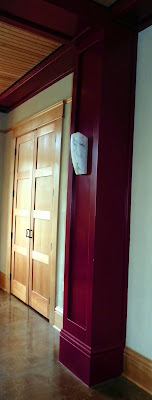
Recently Lama Yeshe gave a talk about the items in the sanctuary. She described leaving ‘the dust of the world’ behind as we take off our shoes and enter the temple through the outside red doors.
In entering the sanctuary, Yeshe pointed out that the doors can never make noise as people come and go. These doors were created by Dougal Haines of Terrebonne, Oregon. People prepare their minds upon entering, often looking towards the Buddha and bowing. At the same time, participants enter the space of their own hearts to find a calming, "not ordinary" presence.
A bell rings to announce the arrival of the teachers. As the Lamas enter the room, those who wish to will stand and hold hands together in a sign of respect. Only when the teachers are seated does everyone sit. There is a relaxed environment of mindfulness, as thousands of years of blessing, intentions and aspirations join together. Recalling the Buddha, we also recall our own Buddha potential. Everything in the room is designed to help us focus our heart and minds.
First seen is usually the image of the Buddha in the front of the room . We remember that thousands have made the same journey that the Buddha made. Each of us has the seeds of awakening inside.
Small windows look out to the hills and there is a view of the wetlands, bringing restful reflections of nature inside. The lighting is effective and calming.

The altar contains representations of the three jewels (Buddha, Dharma and Sangha) and three roots (Lamas, Yidams and Dharma Protectors) of our refuge. One example of these aspects of refuge is the statue of the Buddha on the top area of the shrine. He sits in an immovable triangular posture, metaphorically seated on a lotus flower. Using that as our example, we are reminded of how our body can support our mind in sitting quietly.
The right hand of the Buddha touches the earth. On the night of his enlightenment, the Buddha's serenity invited animals to surround him. The entire planet resonated to indicate his achievement of realization and the limitless quiet mind he had developed. We are reminded in that gesture, that the whole earth is our support for the quest toward realization and limitless quiet mind.










